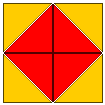- The Babylonians, unlike the early Greeks much later on, interpreted ratios of lengths as numbers.
- They possessed a place-value numbering system. It involved a principal base of 60, but the numbers from 0 to 59 were expressed in base 10. It is not apparent in the picture, but they didn't yet (i.e. in 1600 B.C.) possess a zero. Their representation system was a true floating point system: "30", for example, could be either 30 or 1/2.
- They weren't just finding a good (very good) approximation to the ratio of a diagonal to a side of a square. They knew that the ratio of the diagonal of a square to a side was a number whose square was 2.
- They possessed an algorithm for finding approximations to the square root of 2.


Incidentally, the figure on the right, also closely related to our figure, is itself close to one of the figures found in the equally old tablet B.M. 15285. The second figure is also, remarkably enough, one of the diagrams that accompany Socrates' dialogue with the Greek boy in Plato's Meno, in which Socrates illustrates his claim that all knowledge is somehow innate to the human mind by drawing out of the boy a proof of Pythagoras' theorem for isosceles right triangles.
So in effect, what we are seeing here is one of the very first examples of human reasoning - but visual reasoning, not verbal. Who are we to say how mathematical reasoning evolved? Or that for many purposes visual reasoning is not as valid as verbal?